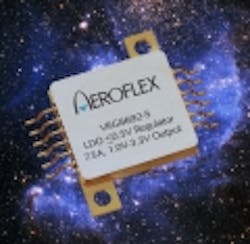Rugged embedded FPGA-based L-Band RF tuner and dual digitizer in PCI Express, 3U VPX, and XMC introduced by Pentek
UPPER SADDLE RIVER, N.J., 1 Dec. 2010. Pentek Inc. in Upper Saddle River, N.J., is introducing the Model 71690 L-Band RF tuner and dual RF digitizerboard product with on-board Xilinx Virtex-6 field-programmable gate array (FPGA) for reception and processing of digitally modulated RF signals such as satellite television and terrestrial wireless communications.
The Model 71690 requires an antenna and host system, such as a personal computer, to form an L-band SDR development platform. The 71690 receives and digitizes signals in the 925 MHz to 2175 MHz (L-band) frequency range with a dynamic range of -75 dBm to 0 dBm.
The 71690's native form factor is a ruggedized XMC module, yet also can be implemented in PCI Express or 3U VPX. Software support includes Windows, Linux, and VxWorks.
Dual 16-bit, 200 MHz A/D converters synchronously sample the I and Q signals, passing them to a Xilinx Virtex-6 FPGA for demodulation, decoding, and decryption. A variety of FPGAs, including the LX130T, LX240T, LX365T, SX315T and SX475T, are available. Four independent memory banks provide the 71690 with a capacity as large as two gigabytes of DDR3 SDRAM for applications requiring deep memory, or as much as 32 megabytes of QDRII+ SRAM for applications requiring fast random access.
Users "can use a single XMC module to receive, demodulate, decode and decrypt virtually any type of digital L-band communications, working directly from an antenna low- noise block connection," says Pentek Vice President Rodger Hosking.
The module's external interfaces include a Gen2 PCI Express bus (x8) for native connection to the host system for control and data transfer. In addition, the module offers application-specific options for installation of 20 LVDS pairs for general-purpose input/output and four gigabit interfaces to support serial protocols.
The RF subsystem can accept an external reference signal or an optional on-board crystal oscillator for its tuning reference. Internal timing generators provide the module's A/D converter sample clock, or users can select an external reference that, along with triggers and other control inputs, allow synchronized operation across multiple modules.
For more information contact Pentek online at www.pentek.com.
